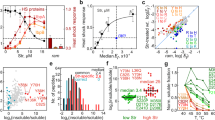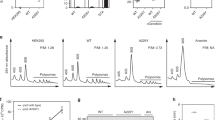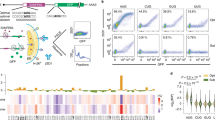Key Points
-
Mistranslation can occur at all steps of protein synthesis, so quality control mechanisms exist at each step of translation.
-
Most of our understanding of translation quality control pathways is based on in vitro studies, but recent efforts have increasingly focused on understanding the in vivo causes and effects of mistranslation.
-
High translational accuracy comes at a price. A balance exists in the cell between the speed of protein synthesis and the rate of mistranslation.
-
Rates of mistranslation in vivo are not fixed but vary between organisms and under different environmental conditions.
-
Although mistranslation is often thought to only be detrimental, under some conditions increased levels of mistranslation may be advantageous.
-
Although many advances have been made in recent years, we still do not have a comprehensive understanding of the factors that modulate translational quality control mechanisms or their effect on cellular physiology.
Abstract
Mistranslation broadly encompasses the introduction of errors during any step of protein synthesis, leading to the incorporation of an amino acid that is different from the one encoded by the gene. Recent research has vastly enhanced our understanding of the mechanisms that control mistranslation at the molecular level and has led to the discovery that the rates of mistranslation in vivo are not fixed but instead are variable. In this Review we describe the different steps in translation quality control and their variations under different growth conditions and between species though a comparison of in vitro and in vivo findings. This provides new insights as to why mistranslation can have both positive and negative effects on growth and viability.
This is a preview of subscription content, access via your institution
Access options
Subscribe to this journal
Receive 12 print issues and online access
$209.00 per year
only $17.42 per issue
Buy this article
- Purchase on Springer Link
- Instant access to full article PDF
Prices may be subject to local taxes which are calculated during checkout


Similar content being viewed by others
References
Johansson, M., Lovmar, M. & Ehrenberg, M. Rate and accuracy of bacterial protein synthesis revisited. Curr. Opin. Microbiol. 11, 141–147 (2008).
Kramer, E. B. & Farabaugh, P. J. The frequency of translational misreading errors in E. coli is largely determined by tRNA competition. RNA 13, 87–96 (2007).
Blank, A., Gallant, J. A., Burgess, R. R. & Loeb, L. A. An RNA polymerase mutant with reduced accuracy of chain elongation. Biochemistry 25, 5920–5928 (1986).
Kunkel, T. A. DNA replication fidelity. J. Biol. Chem. 279, 16895–16898 (2004).
Ling, J., Reynolds, N. & Ibba, M. Aminoacyl-tRNA synthesis and translational quality control. Annu. Rev. Microbiol. 63, 61–78 (2009).
Ibba, M. & Söll, D. Quality control mechanisms during translation. Science 286, 1893–1897 (1999).
Dale, T. & Uhlenbeck, O. C. Amino acid specificity in translation. Trends Biochem. Sci. 30, 659–665 (2005).
Hendrickson, T. L. & Schimmel, P. in Translation Mechanisms (eds Lapointe, J. & Brakier-Gingras, L.) 34–64 (Kluwer Academic/Plenum Publishers, New York, 2003).
Martinis, S. A. & Boniecki, M. T. The balance between pre- and post-transfer editing in tRNA synthetases. FEBS Lett. 584, 455–459 (2010).
Schmidt, E. & Schimmel, P. Mutational isolation of a sieve for editing in a transfer RNA synthetase. Science 264, 265–267 (1994).
Nordin, B. E. & Schimmel, P. Transiently misacylated tRNA is a primer for editing of misactivated adenylates by class I aminoacyl-tRNA synthetases. Biochemistry 42, 12989–12997 (2003).
Gruic-Sovulj, I., Uter, N., Bullock, T. & Perona, J. J. tRNA-dependent aminoacyl-adenylate hydrolysis by a nonediting class I aminoacyl-tRNA synthetase. J. Biol. Chem. 280, 23978–23986 (2005).
Splan, K. E., Ignatov, M. E. & Musier-Forsyth, K. Transfer RNA modulates the editing mechanism used by class II prolyl-tRNA synthetase. J. Biol. Chem. 283, 7128–7134 (2008).
Boniecki, M. T., Vu, M. T., Betha, A. K. & Martinis, S. A. CP1-dependent partitioning of pretransfer and posttransfer editing in leucyl-tRNA synthetase. Proc. Natl Acad. Sci. USA 105, 19223–19228 (2008).
Zhu, B., Yao, P., Tan, M., Eriani, G. & Wang, E. D. tRNA-independent pretransfer editing by class I leucyl-tRNA synthetase. J. Biol. Chem. 284, 3418–3424 (2009).
Dulic, M., Cvetesic, N., Perona, J. J. & Gruic-Sovulj, I. Partitioning of tRNA-dependent editing between pre- and post-transfer pathways in class I aminoacyl-tRNA synthetases. J. Biol. Chem. 285, 23799–23809 (2010).
Minajigi, A. & Francklyn, C. S. Aminoacyl transfer rate dictates choice of editing pathway in threonyl-tRNA synthetase. J. Biol. Chem. 285, 23810–23817 (2010). This paper, together with reference 16, illustrate how tRNA in effect drives misactivated amino acids towards the post-transfer editing pathway.
Tan, M. et al. tRNA-dependent pre-transfer editing by prokaryotic leucyl-tRNA synthetase. J. Biol. Chem. 285, 3235–3244 (2010).
Ling, J. et al. Resampling and editing of mischarged tRNA prior to translation elongation. Mol. Cell 33, 654–660 (2009). This article shows that after aminoacyl-tRNAs bind to elongation factors they are not irreversibly committed to protein synthesis.
Ferri-Fioni, M. L. et al. Structure of crystalline D-Tyr-tRNA(Tyr) deacylase. A representative of a new class of tRNA-dependent hydrolases. J. Biol. Chem. 276, 47285–47290 (2001).
Ahel, I., Korencic, D., Ibba, M. & Söll, D. Trans-editing of mischarged tRNAs. Proc. Natl Acad. Sci. USA 100, 15422–15427 (2003).
An, S. & Musier-Forsyth, K. Trans-editing of Cys-tRNA Pro by Haemophilus influenzae YbaK protein. J. Biol. Chem. 279, 42359–42362 (2004).
Soutourina, O., Soutourina, J., Blanquet, S. & Plateau, P. Formation of D-tyrosyl-tRNATyr accounts for the toxicity of D-tyrosine toward Escherichia coli. J. Biol. Chem. 279, 42560–42565 (2004).
Sokabe, M., Okada, A., Yao, M., Nakashima, T. & Tanaka, I. Molecular basis of alanine discrimination in editing site. Proc. Natl Acad. Sci. USA 102, 11669–11674 (2005).
Hussain, T. et al. Post-transfer editing mechanism of a D-aminoacyl-tRNA deacylase-like domain in threonyl-tRNA synthetase from archaea. EMBO J. 25, 4152–4162 (2006).
Ferri-Fioni, M. L. et al. Identification in archaea of a novel D-Tyr-tRNATyr deacylase. J. Biol. Chem. 281, 27575–27585 (2006).
Wydau, S., Ferri-Fioni, M. L., Blanquet, S. & Plateau, P. GEK1, a gene product of Arabidopsis thaliana involved in ethanol tolerance, is a D-aminoacyl-tRNA deacylase. Nucleic Acids Res. 35, 930–938 (2007).
Guo, M. et al. Paradox of mistranslation of serine for alanine caused by AlaRS recognition dilemma. Nature 462, 808–812 (2009). This study describes the structural basis underlying the need for trans -acting editing factors to maintain fidelity in translation.
Wydau, S., van der Rest, G., Aubard, C., Plateau, P. & Blanquet, S. Widespread distribution of cell defense against D-aminoacyl-tRNAs. J. Biol. Chem. 284, 14096–14104 (2009).
Kaminska, M. et al. Dynamic organization of aminoacyl-tRNA synthetase complexes in the cytoplasm of human cells. J. Biol. Chem. 284, 13746–13754 (2009).
Kyriacou, S. V. & Deutscher, M. P. An important role for the multienzyme aminoacyl-tRNA synthetase complex in mammalian translation and cell growth. Mol. Cell 29, 419–427 (2008).
Cannarrozzi, G. et al. A role for codon order in translation dynamics. Cell 141, 355–367 (2010).
Fredrick, K. & Ibba, M. How the sequence of a gene can tune its translation. Cell 141, 227–229 (2010).
Ogle, J. M. & Ramakrishnan, V. Structural insights into translational fidelity. Annu. Rev. Biochem. 74, 129–177 (2005).
Fischer, N., Konevega, A. L., Wintermeyer, W., Rodnina, M. V. & Stark, H. Ribosome dynamics and tRNA movement by time-resolved electron cryomicroscopy. Nature 466, 329–333 (2010).
Ling, J., Yadavalli, S. S. & Ibba, M. Phenylalanyl-tRNA synthetase editing defects result in efficient mistranslation of phenylalanine codons as tyrosine. RNA 13, 1881–1886 (2007).
Effraim, P. R. et al. Natural amino acids do not require their native tRNAs for efficient selection by the ribosome. Nature Chem. Biol. 5, 947–953 (2009).
Kruger, M. K., Pedersen, S., Hagervall, T. G. & Sorensen, M. A. The modification of the wobble base of tRNAGlu modulates the translation rate of glutamic acid codons in vivo. J. Mol. Biol. 284, 621–631 (1998).
Sorensen, M. A. et al. Over expression of a tRNA(Leu) isoacceptor changes charging pattern of leucine tRNAs and reveals new codon reading. J. Mol. Biol. 354, 16–24 (2005).
Muramatsu, T. et al. Codon and amino-acid specificities of a transfer RNA are both converted by a single post-transcriptional modification. Nature 336, 179–181 (1988).
Thompson, R. C. & Stone, P. J. Proofreading of the codon-anticodon interaction on ribosomes. Proc. Natl Acad. Sci. USA 74, 198–202 (1977).
Bouadloun, F., Donner, D. & Kurland, C. G. Codon-specific missense errors in vivo. EMBO J. 2, 1351–1356 (1983).
Dix, D. B. & Thompson, R. C. Codon choice and gene expression: synonymous codons differ in translational accuracy. Proc. Natl Acad. Sci. USA 86, 6888–6892 (1989).
Pape, T., Wintermeyer, W. & Rodnina, M. Induced fit in initial selection and proofreading of aminoacyl-tRNA on the ribosome. EMBO J. 18, 3800–3807 (1999).
Gromadski, K. B. & Rodnina, M. V. Kinetic determinants of high-fidelity tRNA discrimination on the ribosome. Mol. Cell 13, 191–200 (2004).
Schmeing, T. M. et al. The crystal structure of the ribosome bound to EF-Tu and aminoacyl-tRNA. Science 326, 688–694 (2009).
Zaher, H. S. & Green, R. Quality control by the ribosome following peptide bond formation. Nature 457, 161–166 (2009). This paper describes the discovery of an additional proofreading step on the ribosome that occurs after peptide bond formation.
Zaher, H. S. & Green, R. Kinetic basis for global loss of fidelity arising from mismatches in the P-site codon:anticodon helix. RNA 19 Aug 2010 (doi: 10.1261/rna.2241810).
Marquez, V., Wilson, D. N., Tate, W. P., Triana-Alonso, F. & Nierhaus, K. H. Maintaining the ribosomal reading frame: the influence of the E site during translational regulation of release factor 2. Cell 118, 45–55 (2004).
Sanders, C. L. & Curran, J. F. Genetic analysis of the E site during RF2 programmed frameshifting. RNA 13, 1483–1491 (2007).
Devaraj, A., Shoji, S., Holbrook, E. D. & Fredrick, K. A role for the 30S subunit E site in maintenance of the translational reading frame. RNA 15, 255–265 (2009).
Uemura, S. et al. Real-time tRNA transit on single translating ribosomes at codon resolution. Nature 464, 1012–1017 (2010).
Ling, J., Roy, H. & Ibba, M. Mechanism of tRNA-dependent editing in translational quality control. Proc. Natl Acad. Sci. USA 104, 72–77 (2007).
An, S. & Musier-Forsyth, K. Cys-tRNA Pro editing by Haemophilus influenzae YbaK via a novel synthetase/YbaK/tRNA ternary complex. J. Biol. Chem. 280, 34465–34472 (2005). The publication describes how a trans -acting factor supplements the specificity of an aaRS
Ruan, B. et al. Quality control despite mistranslation caused by an ambiguous genetic code. Proc. Natl Acad. Sci. USA 105, 16502–16507 (2008). A report that provides evidence for the ability of bacteria to withstand various mistranslation events.
Reynolds, N. M. et al. Cell-specific differences in the requirements for translation quality control. Proc. Natl Acad. Sci. USA 107, 4063–4068 (2010).
Lee, J. W. et al. Editing-defective tRNA synthetase causes protein misfolding and neurodegeneration. Nature 443, 50–55 (2006). A pivotal paper that describes how mild editing defects can have catastrophic effects in certain cell types.
Korencic, D. et al. A freestanding proofreading domain is required for protein synthesis quality control in Archaea. Proc. Natl Acad. Sci. USA 101, 10260–10265 (2004).
Nangle, L. A., De Crécy-Lagard, V., Döring, V. & Schimmel, P. Genetic code ambiguity. Cell viability related to the severity of editing defects in mutant tRNA synthetases. J. Biol. Chem. 277, 45729–45733 (2002).
Karkhanis, V. A., Boniecki, M. T., Poruri, K. & Martinis, S. A. A viable amino acid editing activity in the leucyl-tRNA synthetase CP1-splicing domain is not required in the yeast mitochondria. J. Biol. Chem. 281, 33217–33225 (2006).
Hinnebusch, A. G. Translational regulation of GCN4 and the general amino acid control of yeast. Annu. Rev. Microbiol. 59, 407–450 (2005).
Santos, M. A., Perreau, V. M. & Tuite, M. F. Transfer RNA structural change is a key element in the reassignment of the CUG codon in Candida albicans. EMBO J. 15, 5060–5068 (1996).
Bacher, J. M., De Crécy-Lagard, V. & Schimmel, P. R. Inhibited cell growth and protein functional changes from an editing-defective tRNA synthetase. Proc. Natl Acad. Sci. USA 102, 1697–1701 (2005).
Bacher, J. M. & Schimmel, P. An editing-defective aminoacyl-tRNA synthetase is mutagenic in aging bacteria via the SOS response. Proc. Natl Acad. Sci. USA 104, 1907–1912 (2007).
Wrande, M., Roth, J. R. & Hughes, D. Accumulation of mutants in “aging” bacterial colonies is due to growth under selection, not stress-induced mutagenesis. Proc. Natl Acad. Sci. USA 105, 11863–11868 (2008).
Roy, H., Ling, J., Irnov, M. & Ibba, M. Post-transfer editing in vitro and in vivo by the b subunit of phenylalanyl-tRNA synthetase. EMBO J. 23, 4639–4648 (2004).
Lue, S. W. & Kelley, S. O. An aminoacyl-tRNA synthetase with a defunct editing site. Biochemistry 44, 3010–3016 (2005).
Roy, H., Ling, J., Alfonzo, J. & Ibba, M. Loss of editing activity during the evolution of mitochondrial phenylalanyl-tRNA synthetase. J. Biol. Chem. 280, 38186–38192 (2005).
Miranda, I., Silva, R. & Santos, M. A. Evolution of the genetic code in yeasts. Yeast 23, 203–213 (2006).
Santos, M. A., Cheesman, C., Costa, V., Moradas-Ferreira, P. & Tuite, M. F. Selective advantages created by codon ambiguity allowed for the evolution of an alternative genetic code in Candida spp. Mol. Microbiol. 31, 937–947 (1999).
Ruusala, T., Andersson, D., Ehrenberg, M. & Kurland, C. G. Hyper-accurate ribosomes inhibit growth. EMBO J. 3, 2575–2580 (1984).
Bacher, J. M., Waas, W. F., Metzgar, D., de Crécy-Lagard, V. & Schimmel, P. Genetic code ambiguity confers a selective advantage on Acinetobacter baylyi. J. Bacteriol. 189, 6494–6496 (2007).
Nangle, L. A., Motta, C. M. & Schimmel, P. Global effects of mistranslation from an editing defect in mammalian cells. Chem. Biol. 13, 1091–1100 (2006).
Netzer, N. et al. Innate immune and chemically triggered oxidative stress modifies translational fidelity. Nature 462, 522–526 (2009). This article describes the use of a new microarray-based assay to reveal huge increases in tRNA mischarging after exposure to stress.
Levine, R. L., Mosoni, L., Berlett, B. S. & Stadtman, E. R. Methionine residues as endogenous antioxidants in proteins. Proc. Natl Acad. Sci. USA 93, 15036–15040 (1996).
Drummond, D. A. & Wilke, C. O. The evolutionary consequences of erroneous protein synthesis. Nature Rev. Genet. 10, 715–724 (2009).
Ling, J. & Söll, D. Severe oxidative stress induces protein mistranslation through impairment of an aminoacyl-tRNA synthetase editing site. Proc. Natl Acad. Sci. USA 107, 4028–4033 (2010).
Loftfield, R. B. & Vanderjagt, D. The frequency of errors in protein biosynthesis. Biochem. J. 128, 1353–1356 (1972).
Pauling, L. Festschrift für Prof. Dr. Arthur Stoll (Birkhauser Verlag, Basel, Switzerland, 1958).
Crick, F. On protein synthesis. SympSocExpBiol 12, 138–163 (1958).
Baldwin, A. N. & Berg, P. Transfer ribonucleic acid-induced hydrolysis of valyladenylate bound to isoleucyl ribonucleic acid synthetase. J. Biol. Chem. 241, 839–845 (1966).
Giegé, R., Sissler, M. & Florentz, C. Universal rules and idiosyncratic features in tRNA identity. Nucleic Acids Res. 26, 5017–5035 (1998).
McClory, S. P., Leisring, J. M., Qin, D. & Fredrick, K. Missense suppressor mutations in 16S rRNA reveal the importance of helices h8 and h14 in aminoacyl-tRNA selection. RNA 16, 1925–1934 (2010).
Ruusala, T., Ehrenberg, M. & Kurland, C. G. Is there proofreading during polypeptide synthesis? EMBO J. 1, 741–745 (1982).
Acknowledgements
We thank K. Fredrick and T. Bullwinkle for critical reading of the manuscript, and S. Martinis for sharing unpublished results. Work in the authors' laboratories on this topic is supported by the National Science Foundation (MCB 744791 and MCB 744618 to M.I.; MCB 744681 to B.L.).
Author information
Authors and Affiliations
Corresponding author
Ethics declarations
Competing interests
The authors declare no competing financial interests.
Related links
Glossary
- Aminoacyl-tRNA synthetase
-
An enzyme belonging to a family of enzymes that catalyse the direct aminoacylation of the 3′ end of tRNAs with amino acids. The enzymes are denoted by their three-letter amino acid designation; for example, AlaRS is alanyl-tRNA synthetase.
- Aminoacyl-tRNA
-
tRNA with an amino acid covalently attached to its 3′ end: Ala-tRNA denotes tRNA aminoacylated with Ala and tRNAAla denotes uncharged tRNA specific for Ala.
- Cognate
-
Describes two molecules matched correctly according to the rules of the genetic code.
- Editing
-
The hydrolysis of a non-cognate product either before (pre-transfer) or after (post-transfer) the attachment of the non-cognate amino acid to tRNA.
- Trans editing
-
Editing that occurs after near-cognate product dissociation, catalysed by aaRS or another trans-acting factor.
- Deacylate
-
To remove the amino acid from the 3′ end of an aminoacyl-tRNA.
- Wobble
-
Codon–anticodon interaction involving non-Watson–Crick base pairing that generally occurs at the third codon position.
- Cis editing
-
Editing catalysed by the same aaRS that synthesizes the near-cognate product.
- Heat shock response
-
The cellular response to increased temperature or other stresses that result in the accumulation of unfolded proteins.
- Purkinje cell
-
A post-mitotic neuron in the cerebellum that is responsible for motor coordination.
Rights and permissions
About this article
Cite this article
Reynolds, N., Lazazzera, B. & Ibba, M. Cellular mechanisms that control mistranslation. Nat Rev Microbiol 8, 849–856 (2010). https://doi.org/10.1038/nrmicro2472
Published:
Issue Date:
DOI: https://doi.org/10.1038/nrmicro2472
This article is cited by
-
Ribosomal mistranslation leads to silencing of the unfolded protein response and increased mitochondrial biogenesis
Communications Biology (2019)
-
Quality Control by Isoleucyl-tRNA Synthetase of Bacillus subtilis Is Required for Efficient Sporulation
Scientific Reports (2017)
-
A Generalized Michaelis–Menten Equation in Protein Synthesis: Effects of Mis-Charged Cognate tRNA and Mis-Reading of Codon
Bulletin of Mathematical Biology (2017)
-
Recent advances in the biology and drug targeting of malaria parasite aminoacyl-tRNA synthetases
Malaria Journal (2016)
-
The essential mycobacterial amidotransferase GatCAB is a modulator of specific translational fidelity
Nature Microbiology (2016)



